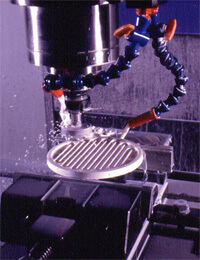MACHINING MACOR®

Machining speed and coolant are decisive for successful machining.
MACOR® machinable glass ceramic can be processed with tools of high-speed steel To achieve a longer service life and better surface finishes, cemented carbide tools are recommended. It is advisable to use plenty of coolant.As with any new material, one should take time to get to know how MACOR® behaves during machining. The best results are achieved with the use of a water-soluble coolant ,especially formulated for cutting and grinding glass or ceramics.
There is no needforpost-firingafter machining.
Setting up
When machining small or delicate workpieces, care should be taken to achieve uniform distribution of clamping load. Soft clamping jaws should be used if possible.
Sawing
It is advisable to use a carbide grit blade at aband speed of 30.5 m/min (100 fpm). A silicon carbide or diamond cut-off wheel can be used as an alternative.
Turning
Withcemented carbide tools.
| Cutting speed: | 9-15 m/min (30-50 sfm) |
| Feed: | 0.005-0.013 cm/rev (0.002-0.005 ipr) |
| Cut depth: | 0.38-0.65 cm (0.150-0.250 in) |
Milling
| Cutting speed: | 6.1-10.7 m/min (20-35 sfm) |
| Chip load: | 0.05 mm per tooth (0.002 ipt) |
| Cutting depth: | 0.38-0.51 cm (0.150-0.200 in) |
Drilling
| Drill size | Spindle speed | Feed rate |
|---|---|---|
| 0.64 cm (1/4 in) | 300 rpm | 0.013 cm/rev (0.005 ipr) |
| 1.27 cm (1/2 in) | 250 rpm | 0.018 cm/rev (0.007 ipr) |
| 1.90 cm (3/4 in) | 200 rpm | 0.025 cm/rev (0.010 ipr) |
| 2.54 cm (1 in) | 100 rpm | 0.030 cm/rev (0.012 ipr) |
| 5.08 cm (2 in) | 50 rpm | 0.038 cm/rev (0.015 ipr) |
The drill feed rate should be chosen to suit the hole diameter and MACOR® workpiece thickness.
For break-out, at least 0.13 cm (0.05 in) extra material should be provided on the reverse. This excess material can be removed after drilling.
Tapping
The clearance/pilot holes should be 0.2 – 0.3 mm larger than those recommended for metals. Chamfer both ends of the hole to prevent chipping. Run the tap in one direction only, as forward and reverse turning of the tap can cause chipping. Constant rinsing with water and coolant removes chips and dust from the tap.
Grinding
Diamond, silicon carbide or aluminium oxide grinding wheels can be used.
Polishing
HOME with loose 400-grit silicon carbide on a steel wheel. For the final polish, use cerium dioxide or alumina on a buffing wheel for glass or ceramics. A 0.013 µm (0.5 µin) finish can be achieved.
Contact Arrange a Tour